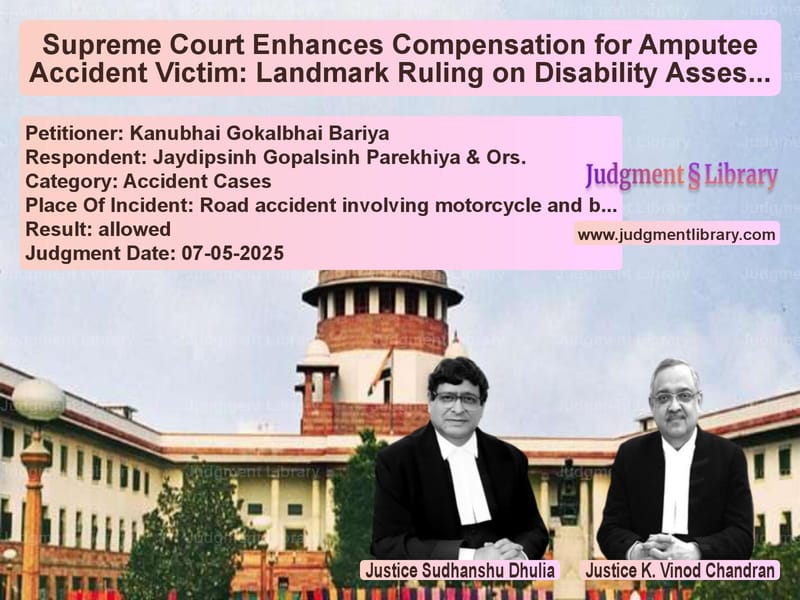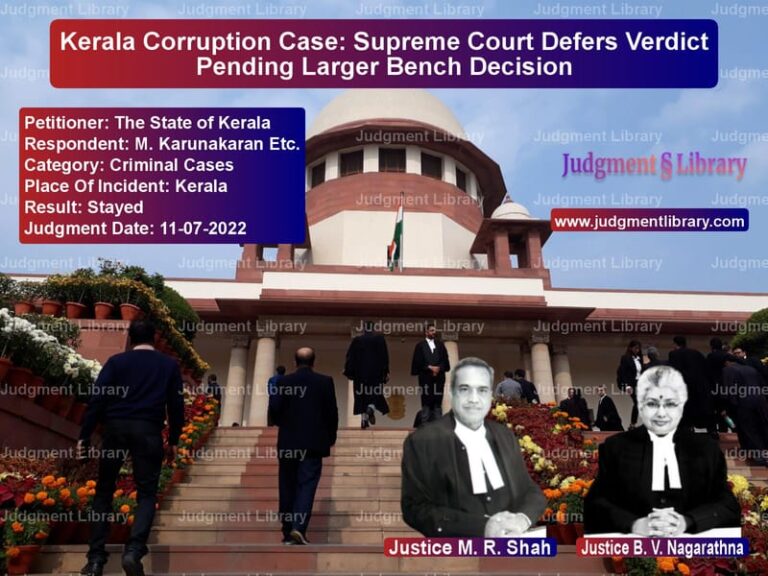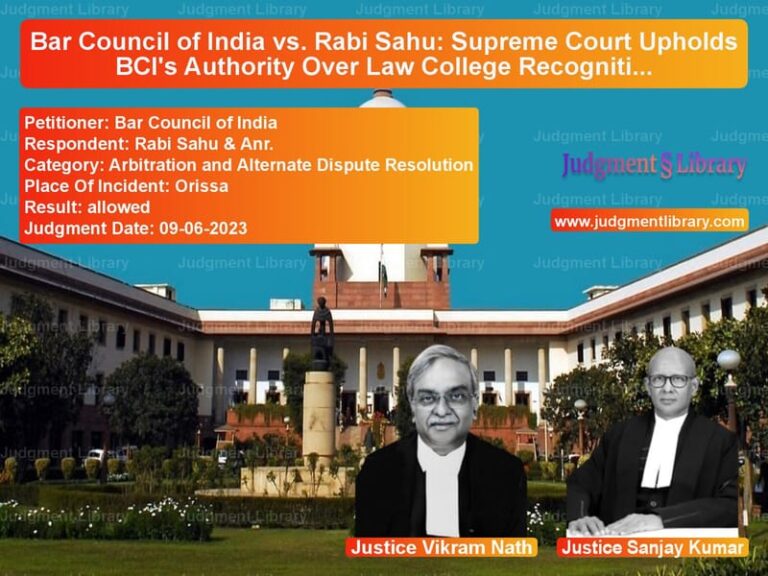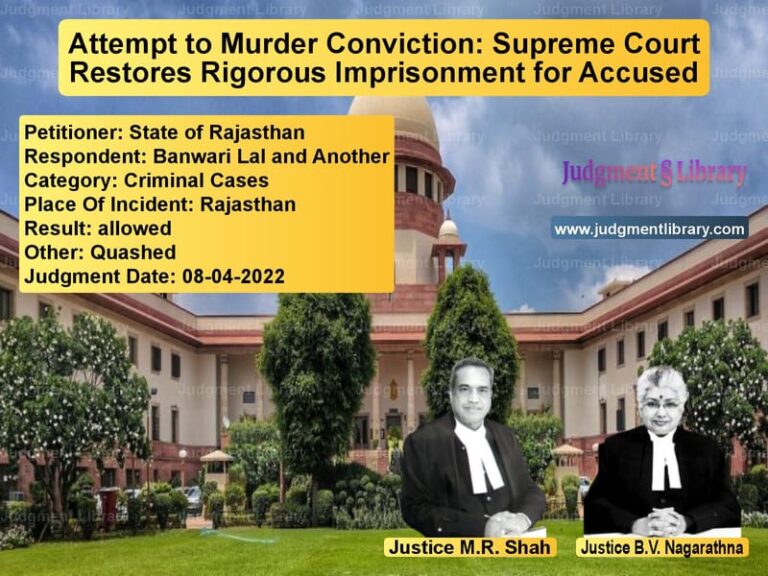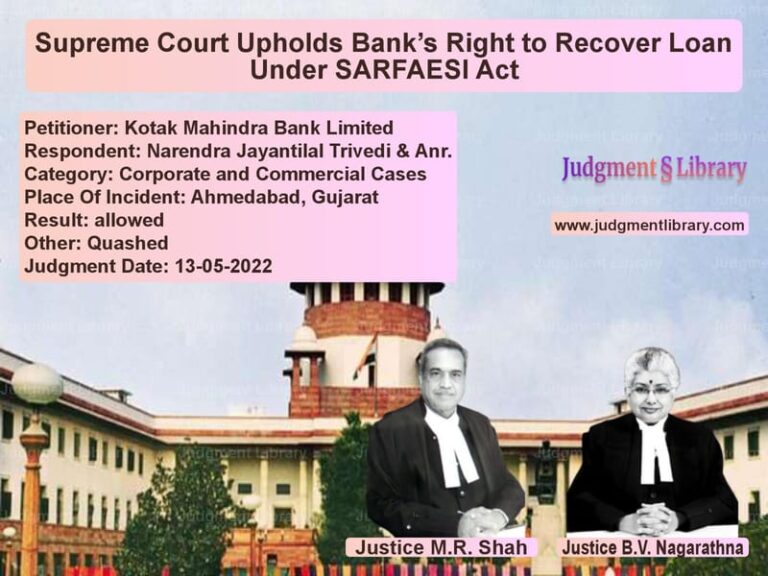Supreme Court Enhances Compensation for Amputee Accident Victim: Landmark Ruling on Disability Assessment
In a significant judgment that reinforces the principles of just compensation for accident victims, the Supreme Court of India has substantially enhanced the compensation awarded to a man who lost his leg in a horrific road accident. The case of Kanubhai Gokalbhai Bariya, who suffered a below-knee amputation and hand deformation after a bus rammed into the motorcycle he was travelling on, highlights the judiciary’s commitment to ensuring that compensation truly reflects the lifelong impact of severe disabilities.
The tragic incident occurred when Kanubhai was travelling pillion on a motorcycle that was hit by a bus, resulting in the death of the motorcycle driver and leaving Kanubhai with life-altering injuries. His right leg had to be amputated below the knee, and his right hand was permanently deformed from the injuries sustained. The accident not only caused immense physical suffering but also ended his employment as a watchman, plunging him into financial uncertainty at a time when he needed medical care and rehabilitation the most.
The legal journey that followed saw the case move through the Motor Accident Claims Tribunal to the High Court and finally to the Supreme Court, with each court applying different standards to determine what constituted ‘just compensation’ for a man who had lost his livelihood along with his limb. The Supreme Court’s intervention ultimately led to a compensation package that more accurately reflected the permanent nature of his disability and its impact on his earning capacity.
The Accident and Initial Legal Proceedings
The appellant, Kanubhai Gokalbhai Bariya, had sought a total compensation of Rs. 35,00,000 from the Motor Accident Claims Tribunal, asserting that he earned Rs. 12,000 per month as a watchman – employment he could no longer continue due to his amputated leg and deformed hand. The Tribunal conducted a thorough examination of the evidence and made several key determinations that would form the basis of subsequent appeals.
The Tribunal found that there was contributory negligence in the accident, apportioning 20% liability to the motorcycle driver and 80% to the bus driver. This finding was significant as it determined how the compensation would be shared between the insurance companies of the two vehicles.
Regarding income, the Tribunal noted that “the income of the injured as per the documents produced clearly indicated Rs.9,918/-“ and adopted this figure for calculating loss of income. The Tribunal recognized that the loss was permanent due to the nature of the injuries and relied on the precedent set in Raj Kumar v. Ajay Kumar to determine 55% functional disability.
The Tribunal awarded various heads of compensation including Rs. 50,000 for disability, Rs. 20,000 for loss of income for two months, and full reimbursement of medical bills amounting to Rs. 5,17,850, along with an additional Rs. 10,000 for special diet. The total compensation awarded by the Tribunal came to Rs. 16,34,650 with interest at 9% per annum.
The High Court’s Decision
Dissatisfied with the Tribunal’s award, Kanubhai approached the High Court, which made some modifications to the compensation package. The High Court granted a 40% increase in income, following the principles established in the landmark Pranay Sethi case regarding future prospects.
However, the High Court calculated the actual loss of income for six months with future prospects included, an approach that the Supreme Court would later find problematic. The Supreme Court noted that “according to us, that may not be correct since 40% increase is to take in the future prospects of the injured and as on the date of accident when the income is proved, the loss of income should be based on the income proved before the Tribunal.”
The Supreme Court, while conscious that the Insurance Company was not before them, reduced this amount to Rs. 60,000 for six months, emphasizing that “just compensation is to be paid.”
The Supreme Court’s Landmark Analysis
Before the Supreme Court, the appellant’s counsel made compelling arguments for enhanced compensation. The counsel contended that “he was working as a watchman and considering the amputation, his disability would be 100%.” The counsel also sought increases in other compensation heads, including pain and suffering.
The Supreme Court, comprising Justices Sudhanshu Dhulia and K. Vinod Chandran, delved deep into the principles governing disability assessment in compensation cases. The Court referenced Raj Kumar v. Ajay Kumar, which established that “the disability assessed for determining compensation should be the functional disability.”
In Kanubhai’s case, the physical disability was proved by the evidence of a doctor who examined him and assessed his physical disability. The Court noted that “the certificate proved by the doctor clearly indicated 80% disability with respect to his amputated leg and 10% disability insofar as the deformed right hand.”
A crucial piece of evidence that significantly influenced the Court’s decision was the doctor’s testimony that “the stump of the right leg was also deformed and there was no possibility of using an artificial limb.” This meant that Kanubhai would never be able to use a prosthetic limb to mitigate his disability, making his condition permanent and severely limiting his mobility.
Considering all evidence, the Supreme Court determined that “the disability of the appellant would be 80% only considering the fact that the appellant could still move on crutches.” While this was lower than the 100% disability argued by the appellant’s counsel, it was significantly higher than the 55% functional disability adopted by the lower courts.
Comprehensive Compensation Assessment
The Supreme Court undertook a meticulous recalculation of all compensation heads, recognizing the profound impact the injuries had on every aspect of Kanubhai’s life.
For loss of future income, the Court applied the multiplier method, using the established formula: “Loss of income Rs. 9,818/- x 140% x 12 x 16 x 80%” which amounted to Rs. 21,11,262.72. This calculation incorporated the 40% future prospects increase approved in Pranay Sethi, applied over a 16-year multiplier considering Kanubhai’s age, and accounted for the 80% functional disability.
The Court significantly enhanced compensation for non-pecuniary damages, recognizing the immense suffering Kanubhai had endured. The Court held that “the pain and suffering of the appellant has to be increased along with an increase for special diet and attendant charges.” The compensation for pain and suffering was raised to Rs. 1,00,000.
For attendant charges and special diet, the Court noted that “the appellant had been in hospital for one and a half months and due to the amputation, would have definitely suffered bed rest for some time” and accordingly awarded Rs. 15,000 per month for six months, totaling Rs. 90,000.
The medical bills of Rs. 5,17,850 were fully allowed, and loss of income during the recovery period was set at Rs. 60,000 for six months.
The Final Compensation Package
The Supreme Court’s comprehensive assessment resulted in a total compensation of Rs. 28,79,112.72, significantly higher than the Tribunal’s award of Rs. 16,34,650 and representing a more realistic assessment of the lifelong impact of Kanubhai’s disabilities.
The Court maintained the apportionment of liability determined by the Tribunal, ordering that “the above amount shall be apportioned in the ratio of 20:80 as against the insurer of the bike and the bus.”
The Court directed that “the awarded amounts shall be paid within a period of two months from today with interest @ 9% per annum as ordered by the Tribunal and whatever amounts have already been paid shall be deducted.” The Court also specified modern banking procedures, ordering that “the appellant shall provide the bank account details to the Insurance Companies who shall transfer the amount online within the period specified hereinabove.”
Broader Implications of the Judgment
This Supreme Court judgment has significant implications for accident compensation cases across India, particularly those involving permanent disabilities. The Court’s insistence on applying the functional disability principle rather than merely the physical disability percentage ensures that compensation reflects the actual impact on the victim’s earning capacity and quality of life.
The judgment reinforces the judiciary’s role in ensuring that compensation is not just mathematically calculated but truly ‘just’ and commensurate with the suffering and lifelong challenges faced by accident victims. The Court’s careful consideration of medical evidence, particularly the impossibility of using an artificial limb, demonstrates a nuanced understanding of how disabilities affect victims differently.
Furthermore, the judgment clarifies the proper application of future prospects in income calculation, ensuring that victims are compensated not just for their current earnings but for their potential career growth that has been cut short by disability.
For Kanubhai Gokalbhai Bariya, the Supreme Court’s judgment brings closure to a long legal battle and provides financial security that acknowledges the profound changes the accident brought to his life. While no amount of money can truly compensate for the loss of a limb and the suffering endured, the enhanced compensation will at least ensure that he does not face financial hardship in addition to his physical challenges.
The case stands as an important precedent for future accident claims, particularly those involving amputations and permanent disabilities, ensuring that victims receive compensation that truly reflects the lifelong impact of their injuries.
Petitioner Name: Kanubhai Gokalbhai Bariya.Respondent Name: Jaydipsinh Gopalsinh Parekhiya & Ors..Judgment By: Justice Sudhanshu Dhulia, Justice K. Vinod Chandran.Place Of Incident: Road accident involving motorcycle and bus.Judgment Date: 07-05-2025.Result: allowed.
Don’t miss out on the full details! Download the complete judgment in PDF format below and gain valuable insights instantly!
Download Judgment: kanubhai-gokalbhai-b-vs-jaydipsinh-gopalsinh-supreme-court-of-india-judgment-dated-07-05-2025.pdf
Directly Download Judgment: Directly download this Judgment
See all petitions in Road Accident Cases
See all petitions in Compensation Disputes
See all petitions in Motor Vehicle Act
See all petitions in Negligence Claims
See all petitions in Worksite Accidents
See all petitions in Judgment by Sudhanshu Dhulia
See all petitions in Judgment by K. Vinod Chandran
See all petitions in allowed
See all petitions in supreme court of India judgments May 2025
See all petitions in 2025 judgments
See all posts in Accident Cases Category
See all allowed petitions in Accident Cases Category
See all Dismissed petitions in Accident Cases Category
See all partially allowed petitions in Accident Cases Category

